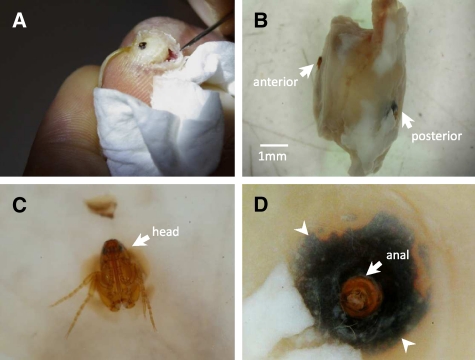A healthy 26-year-old Taiwanese man working in the Democratic Republic of Sao Tome and Principe in West Africa presented with a brownish lesion on the medial edge of his right third toe (Figure 1). Examination found multiple eggs of sand flea Tunga penetrans (white arrowhead in Figure 1 ) after applying lateral pressure. After the excision of the embedded jigger flea from the brownish lesion (Figure 2 ), he recovered completely. Endemic is in sub-Saharan Africa, Caribbean region, Latin America, and the subtropical regions of Asia.1 Tungiasis is an ectoparasitosis involved in the periungual regions of the skin burrowed by the female sand flea2; the infestation usually occurs over unprotected feet. The lesion contained hindquarters of the dead female sand fleas, which deposit hundreds of eggs in the skin tissues (Figure 2), and can become the source of bacterial superinfection. Early recognition and excision is curative.
Figure 1.
A white-yellowish, small (4 mm in diameter) nodule with a notable central pigmented ring was observed on the right forefinger. Multiple eggs were deposited below this lesion and great toe (arrowheads).
Figure 2.
Dermoscopic image of the nodule and extraction of the jigger flea (Tunga penetrans) with a sterile needle. (A) The flea with its white-yellowish abdomen enlarged markedly to ∼4 mm in size with eggs; (B) lateral view of the head and abdomen of the flea; (C) frontal view of the head of the flea; (D) posterior abdomen of Tunga penetrans (arrowheads) with a central pigmented ring (arrow) that corresponds to the pigmented chitin surrounding the posterior opening of the exoskeleton.
Footnotes
Authors' addresses: Kun-Hsien Tsai and Chi-Tai Fang, Institute of Epidemiology and Preventive Medicine, College of Public Health, National Taiwan University, Taipei, Taiwan, Republic of China, E-mails: kunhtsai@ntu.edu.tw and fangct@ntu.edu.tw. Jih-Ching Lien, Taiwan Anti-malaria Advisory Mission in the Democratic Republic of Sao Tome and Principe, Ministry of Foreign Affairs of Taiwan, Taipei City, Taiwan, Republic of China, E-mail: jclien1217@gmail.com.
References
- 1.Heukelbach J, Oliveira FA, Hesse G, Feldmeier H. Tungiasis: a neglected health problem of poor communities. Trop Med Int Health. 2001;6:267–272. doi: 10.1046/j.1365-3156.2001.00716.x. [DOI] [PubMed] [Google Scholar]
- 2.Lefebvre M, Capito C, Durant C, Hervier B, Grossi O. Tungiasis: a poorly documented tropical dermatosis. Med Mal Infect. 2011;41:465–468. doi: 10.1016/j.medmal.2011.05.007. [DOI] [PubMed] [Google Scholar]




